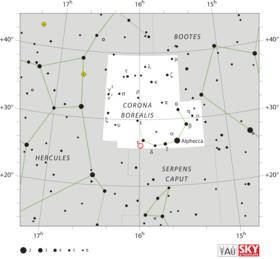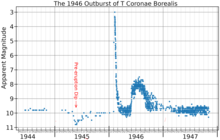
Corona Borealis is a small constellation in the Northern Celestial Hemisphere. It is one of the 48 constellations listed by the 2nd-century astronomer Ptolemy, and remains one of the 88 modern constellations. Its brightest stars form a semicircular arc. Its Latin name, inspired by its shape, means "northern crown". In classical mythology Corona Borealis generally represented the crown given by the god Dionysus to the Cretan princess Ariadne and set by her in the heavens. Other cultures likened the pattern to a circle of elders, an eagle's nest, a bear's den or a smokehole. Ptolemy also listed a southern counterpart, Corona Australis, with a similar pattern.
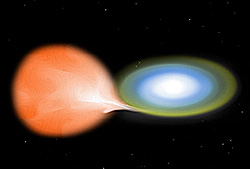
A nova is a transient astronomical event that causes the sudden appearance of a bright, apparently "new" star that slowly fades over weeks or months. All observed novae involve white dwarfs in close binary systems, but causes of the dramatic appearance of a nova vary, depending on the circumstances of the two progenitor stars. The main sub-classes of novae are classical novae, recurrent novae (RNe), and dwarf novae. They are all considered to be cataclysmic variable stars.

R Coronae Borealis is a low-mass yellow supergiant star in the constellation of Corona Borealis. It is the prototype of the R Coronae Borealis variable of variable stars, which fade by several magnitudes at irregular intervals. R Coronae Borealis itself normally shines at approximately magnitude 6, just about visible to the naked eye, but at intervals of several months to many years fades to as faint as 15th magnitude. Over successive months it then gradually returns to its normal brightness, giving it the nickname "reverse nova", after the more common type of star which rapidly increases in brightness before fading.

Alpha Coronae Borealis, officially named Alphecca, is an eclipsing binary star in the constellation of Corona Borealis. It is located about 75 light years from the Sun and contains two main sequence stars, one class A and one class G.

Rho Coronae Borealis is a yellow dwarf star 57.1 light-years away in the constellation of Corona Borealis. The star is thought to be similar to the Sun with nearly the same mass, radius, and luminosity. It is orbited by four known exoplanets.

Beta Coronae Borealis is a binary star in the constellation of Corona Borealis. It appears to the naked eye to be a single star and is the second-brightest star in its constellation with an apparent visual magnitude varying between 3.65 and 3.72. Based on parallax measurements taken during the Hipparcos mission, it is approximately 112 light-years from the Sun.
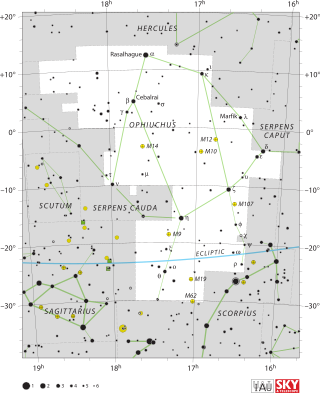
RS Ophiuchi is a recurrent nova system approximately 5,000 light-years away in the constellation Ophiuchus. In its quiet phase it has an apparent magnitude of about 12.5. It has been observed to erupt in 1898, 1933, 1958, 1967, 1985, 2006 and 2021 and reached about magnitude 5 on average. A further two eruptions, in 1907 and 1945, have been inferred from archival data. The recurrent nova is produced by a white dwarf star and a red giant in a binary system. About every 15 years, enough material from the red giant builds up on the surface of the white dwarf to produce a thermonuclear explosion. The white dwarf orbits close to the red giant, with an accretion disc concentrating the overflowing atmosphere of the red giant onto the white dwarf.

Kappa Coronae Borealis, Latinized from κ Coronae Borealis, is a star approximately 98 light years away in the constellation of Corona Borealis. The apparent magnitude is +4.82 and the absolute magnitude is +2.35. It is an orange K-type subgiant star of spectral type K1IV, meaning it has almost completely exhausted its hydrogen supply in its core. It is 1.32 times as massive as the Sun yet has brightened to 11.6 times its luminosity. Around 2.5 billion years old, it was formerly an A-type main sequence star.
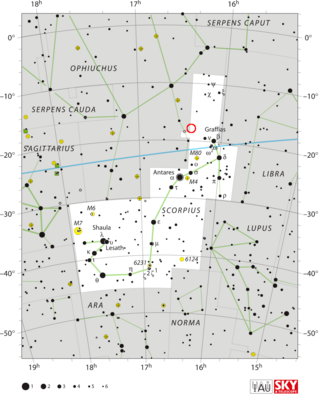
U Scorpii is a recurrent nova system; one of 10 known recurring novae in the Milky Way galaxy. Located near the northern edge of the constellation Scorpius it normally has a magnitude of 18, but reaches a magnitude of about 8 during outbursts. Outbursts have been observed in 1863, 1906, 1936, 1979, 1987, 1999, 2010, and 2022.

Gamma Coronae Borealis, Latinized from γ Coronae Borealis, is a binary star system in the northern constellation of Corona Borealis. It is visible to the naked eye with an apparent visual magnitude of 3.83. Based upon an annual parallax shift of 22.33 mas as seen from Earth, it is located about 146 light years from the Sun. The system is moving closer to the Sun with a radial velocity of about −15 km/s.

Theta Coronae Borealis, Latinized from θ Coronae Borealis, is a binary star system in the constellation Corona Borealis. It shines with a combined apparent visual magnitude of 4.13. There are two components: Theta Coronae Borealis A with an apparent magnitude of about 4.2, while Theta Coronae Borealis B lies around 1 arcsecond distant and has an apparent magnitude of 6.29. The system is located around 375 light-years from Earth, as estimated from its parallax of 8.69 milliarcseconds. It is estimated to be 85 million years old, with the primary star expected to remain on the main sequence burning its core hydrogen for another 75 million years and the secondary around 500 million years. Both stars will cool and expand once their core hydrogen is exhausted, becoming red giants.

Delta Coronae Borealis, Latinized from δ Coronae Borealis, is a variable star in the constellation Corona Borealis. Its apparent magnitude varies regularly between apparent magnitude 4.57 and 4.69, and it is around 170 light-years distant.
Tau Coronae Borealis, Latinized from τ Coronae Borealis, is a possible astrometric and spectroscopic binary star system in the northern constellation of Corona Borealis. It is visible to the naked eye with an apparent visual magnitude of 4.76.
Iota Coronae Borealis, Latinized from ι Coronae Borealis, is a binary star system in the constellation Corona Borealis. It is visible to the naked eye with a combined apparent visual magnitude of is 4.96. Based upon an annual parallax shift of 10.46 mas as seen from the Earth, it is located about 312 light years from the Sun.

Lambda Coronae Borealis, its name Latinised from λ Coronae Borealis, is a single star in the northern constellation of Corona Borealis. In publications it is also identified as HR 5936 and HD 142908. It has a yellow-white hue and is dimly visible to the naked eye with an apparent visual magnitude of 5.43. The star is located at a distance of 136 light years based on parallax, but is drifting closer with a radial velocity of −12 km/s.

RY Sagittarii is a yellow supergiant and an R Coronae Borealis type variable star in the constellation Sagittarius. Although it ostensibly has the spectrum of a G-type star, it differs markedly from most in that it has almost no hydrogen and much carbon.

AG Pegasi is a symbiotic binary star in the constellation Pegasus. It is a close binary composed of a red giant and white dwarf, estimated to be around 2.5 and 0.6 times the mass of the Sun respectively. It is classified as a symbiotic nova; it has undergone one extremely slow nova outburst and a smaller outburst.

Sigma Coronae Borealis is a star system in the constellation of Corona Borealis. It is a quintuple star system containing three sunlike main-sequence stars and two other low-mass stars. The combined visual magnitude is 5.3 and the system lies 74 light years from Earth. σ CrB A is the variable star TZ Coronae Borealis.

IM Normae is a recurrent nova in the constellation Norma, one of only ten known in the Milky Way. It has been observed to erupt in 1920 and 2002, reaching magnitude 8.5 from a baseline of 18.3. It was poorly monitored after the first eruption, so it is possible that it erupted in between these dates.
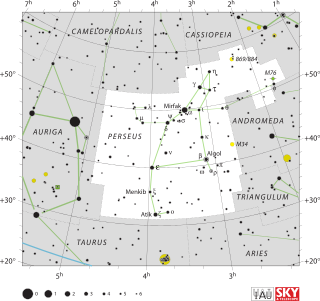
V392 Persei, also known as Nova Persei 2018, is a bright nova in the constellation Perseus discovered on April 29, 2018. It was previously known as a dwarf nova.
